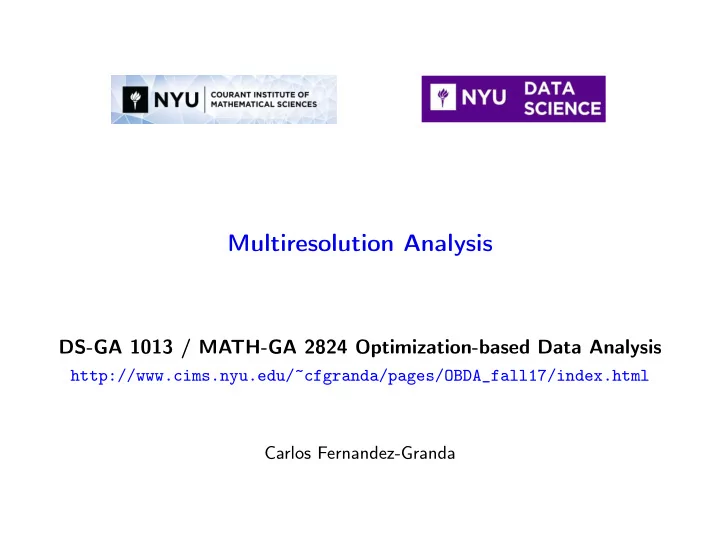

Multiresolution decomposition V k := W k ⊕ V k + 1 ψ dilated by 2 k and shifted by multiples of 2 k + 1 W k is the span of � W 0 W 2
Multiresolution decomposition V k := W k ⊕ V k + 1 ψ dilated by 2 k and shifted by multiples of 2 k + 1 W k is the span of � W 0 W 2 x at scale 2 k P V k � x is an approximation of �
Multiresolution decomposition Properties ◮ V 0 = C n (approximation at scale 2 0 is perfect) ◮ V k is invariant to translations of scale 2 k ◮ Dilating vectors in V j by 2 yields vectors in V j + 1
Electrocardiogram Signal Haar transform
Scale 2 9 P W 9 � P V 9 � x x
Scale 2 8 P W 8 � P V 8 � x x
Scale 2 7 P W 7 � P V 7 � x x
Scale 2 6 P W 6 � P V 6 � x x
Scale 2 5 P W 5 � P V 5 � x x
Scale 2 4 P W 4 � P V 4 � x x
Scale 2 3 P W 3 � P V 3 � x x
Scale 2 2 P W 2 � P V 2 � x x
Scale 2 1 P W 1 � P V 1 � x x
Scale 2 0 P W 0 � P V 0 � x x
2D Wavelets Extension to 2D by using outer products of 1D atoms � T � ξ 2D s 1 , s 2 , k 1 , k 2 := ξ 1D ξ 1D s 1 , k 1 s 2 , k 2 The JPEG 2000 compression standard is based on 2D wavelets Many extensions: Steerable pyramid, ridgelets, curvelets, bandlets, . . .
2D Haar transform
2D wavelet transform
2D wavelet transform
Frames Short-time Fourier transform (STFT) Wavelets Thresholding
Denoising Aim: Extracting information (signal) from data in the presence of uninformative perturbations (noise) Additive noise model data = signal + noise � y = � x + � z Prior knowledge about structure of signal vs structure of noise is required
Assumption ◮ Signal is a sparse superposition of basis/frame vectors ◮ Noise is not
Assumption ◮ Signal is a sparse superposition of basis/frame vectors ◮ Noise is not Example: z with covariance matrix σ 2 I , distribution of F � Gaussian noise � z ?
Example Data Signal
Thresholding Hard-thresholding operator � � if | � v [ j ] v [ j ] | > η H η ( � v ) [ j ] := 0 otherwise
Denoising via hard thresholding Estimate Signal
Multisinusoidal signal � y F � y Data Data Signal
Denoising via hard thresholding Data: � y = � x + � z Assumption: F � x is sparse, F � z is not 1. Apply the hard-thresholding operator H η to F � y 2. If F is a basis, then x est := F − 1 H η ( F � � y ) If F is a frame, x est := F † H η ( F � � y ) , where F † is the pseudoinverse of F (other left inverses of F also work)
Denoising via hard thresholding in Fourier basis � y F � y Data Data Signal
Denoising via hard thresholding in Fourier basis F − 1 H η ( F � y ) H η ( F � y ) Estimate Estimate Signal
Image denoising � x F � x
Image denoising � z F � z
Data (SNR=2.5) � y F � y
F � y
H η ( F � y )
F − 1 H η ( F � y )
� y
Data (SNR=1) � y F � y
F � y
H η ( F � y )
F − 1 H η ( F � y )
� y
Image denoising F − 1 H η ( F � � y ) � y x
Denoising via thresholding F − 1 H η ( F � � y ) � y x
Speech denoising
Recommend
More recommend